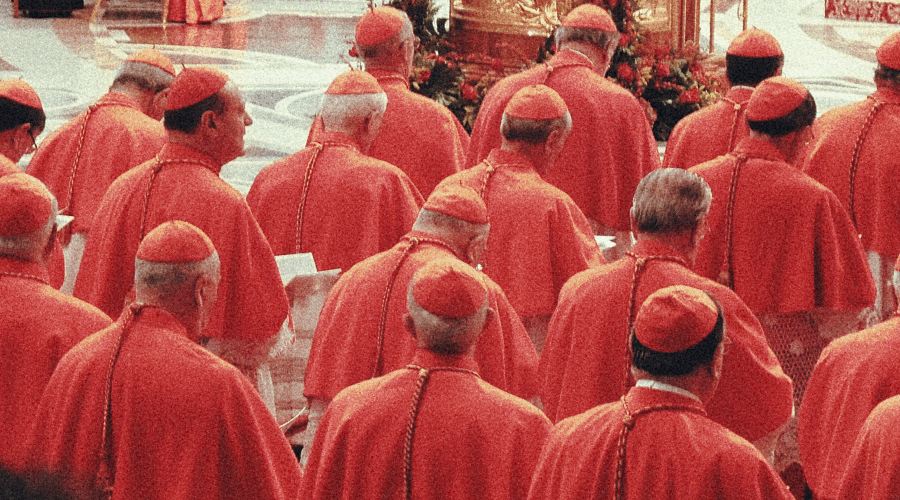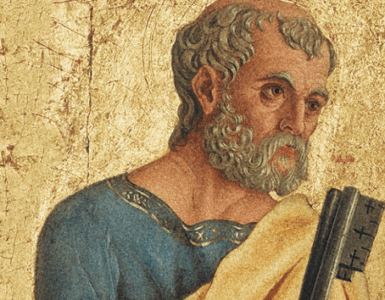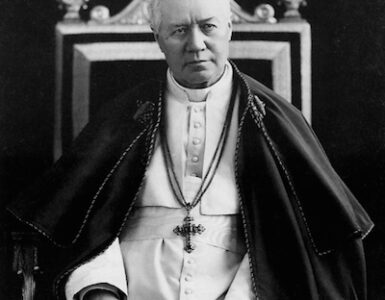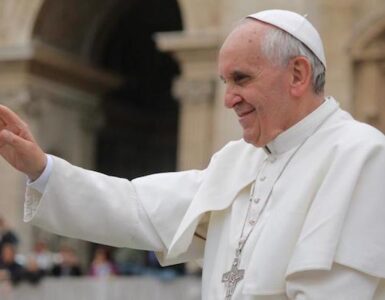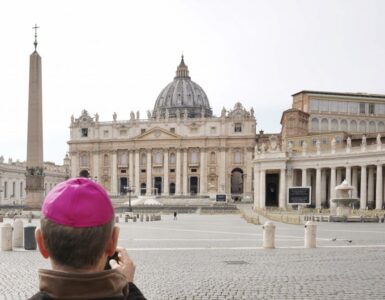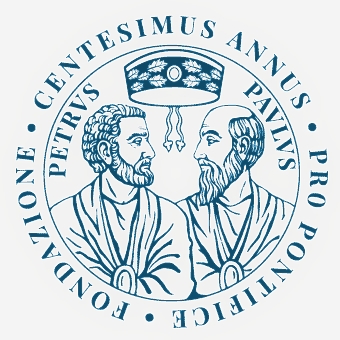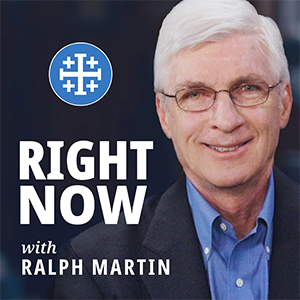It is springtime when my fancy usually turns to baseball. Though I have never been a St. Louis Cardinals fan, they have usually been a part of any baseball conversation, especially when we lived in St. Louis. Lately, the Cardinals have dominated all the headlines in newspapers and the universal media. But I am not talking about baseball. In a way this is springtime for the 135 Catholic Cardinals, eligible to vote for a new pontiff.
With the death of the 266th pope in Church history, Cardinals from all over the world are hurrying to Rome to begin their first Conclave in 12 years. I am certain the news hounds will document every public second of it though this promises to be very limited, given the Vatican’s ultimate secrecy on its proceedings.
I have already dipped my creative toes into these waters with my previous essay, Looking for Loopholes, on the film Conclave. The film’s producers’ timing could not have been better. Perhaps, it was serendipity or the bold fact of Pope Francis’ advanced age of 88 that inspired them.
While this essay is not specifically about either the death of Pope Francis, nor speculation on whom his successor will be, I plan to loosely address my limited relationship with and understanding of members of this particular Holy office in the Church.
Personally, I hope the Cardinals will pick a pope who is not the exact image of his predecessor. Pope Francis had said some things which confused many of us in the pews. Perhaps they will choose someone to redirect the Church closer to its center. If they pick a relatively young man, the chances are that he will have a long reign as head of the Catholic Church.
It should be of no surprise that the longest ruling pope was St. Peter who was head of the Church for 34 years, having been only 30 years old when Jesus chose him as the Rock of His Church. Pope Pius IX ruled for 31 years, from 1846-1875 to rank just behind St. Peter.
Conversely, some popes’ reigns have been very short. Most people would guess that John Paul I’s was the shortest reign with a mere 33 days as pontiff in 1978. He is only 11th on the list. Pope Urban died just 13 days after being instituted. He is followed by Pope Boniface’s 16 days.
My earliest memories of the idea of a Cardinal date back to the powerful figure of Cardinal Spellman of New York City who served as its Archbishop from 1939 until his death in 1967. His status in my eyes greatly declined when he fell out with Bishop Fulton J. Sheen over payment for powdered milk, donated by the Federal Government to the New York Archdiocese. Sheen refused to heed the Cardinal’s orders that he pay $300,000 for the milk out of the funds from his Society for the Propagation of the Faith because he viewed the Cardinal’s demands as a violation of his fiduciary relationship with the donors to his organization.
As a result, the Cardinal unleashed his revenge on Sheen. Consequently, he drove Sheen from the air, made him unwelcome in New York City and got Pope Paul VI to nominate him as the bishop of the diocese of Rochester where Sheen’s rule can only be viewed as a colossal failure. As a result, millions of Catholics were denied the Bishop’s inspirational musings on radio and TV because of Cardinal Spellman’s vindictiveness.
During my lifetime, I have met three Cardinals, the late Edward Cardinal Egan, Raymond Cardinal Burke and the current Archbishop of New York, Timothy Cardinal Dolan. I remember my wife Judy and I entering the aisle after a Mass in St. Patrick’s Cathedral when we literally ran into Cardinal Egan as he was rushing somewhere. During the ensuing short chat, my wife asked him to pray for her upcoming abdominal surgery. He graciously agreed.
We got to know Cardinal Burke when he was the prelate of the Archdiocese of St. Louis. I remember when I barged in front of him in the buffet line in the owners’ box at Busch Stadium during a baseball game with the baseball Cardinals, circa 2006. I was really hungry and the New Yorker in me emerged in its rudest form. Some people, let alone a leader of the Church, would have been very cross with me. Not this Cardinal! I will never forget his warm, Irish smile. I have been a fan of his ever since. We supported him during all the vitriol that he endured from many of the lay people in the diocese due to some of his decisions.
I first met Cardinal Dolan when we were both board members of the Birthright of St. Louis organization many years ago. He always impressed me as a jovial and good-natured man. The only other occasion was when we were in New York and after Mass at the Cathedral we waited for him to come back to the altar but only had a brief chance to tell him we were also from St. Louis.
While I never had the good fortune of meeting the New York City prelate, the late Cardinal John O’Connor, Judy and I did attend a Mass or two where he officiated at the Five PM Mass. One Mass was unforgettable. Instead of giving a sermon, the Cardinal introduced the congregation to his special guest, a petite nun, dressed in white with blue trim habit.
The Church figuratively glowed when Mother Teresa addressed us from the side pulpit. While no nimbus emanated from the crown of her habit, we were truly in the presence of sainthood. To her dying day, Judy raved about that moment we had shared. She prided herself on repeating her sad commentary on women, which I later put on her tombstone at Holy Cross Cemetery in Ellisville, Missouri when she died in 2016.
Oh my, what has become of the world when women are killing their babies.
I got the idea for this essay shortly before my operation for my second cochlear implant in mid-April. The operation was far more difficult for me than the first one five years ago for my right ear. As a result, it has taken me over two weeks to find the strength and concentration to put pen to paper.
This was very fortuitous for me because during my convalescence my wife Anna and I watched a number of movies from my sizable library. One of them was the 1963 film, The Cardinal, which I have had for several years. I also read the original paperback (an abridged edition.) of Henry Morton Robinson’s book, which I found many years ago among my late mother’s possessions. I mentioned this book in a past essay, The Womb of my Catholic Imagination,written six years ago. This is a story which should still resonate well with the Catholic public.
Robinson had enjoyed little success as an author until he wrote the Cardinal. It resonated with millions of readers, not all of them Catholic. Time Magazine praised it as the Year’s most popular book, fiction or non-fiction, despite its 700-page girth. It also won the Golden Globe Award for Best Picture, a rarity for a film that was not nominated for an Academy Award. The Cardinal was, however, nominated for several individual awards, including Otto Preminger as Best Director and John Huston for Best Supporting Actor. Many say that the film is loosely based on the life of New York’s Cardinal Spellman (1889-1967)
Actor Tom Tryon is credible as the diocesan priest, Father Stephen Fermoyle. The film portrays his life in a series of flashbacks while he is pondering his life leading to the point where he is instituted a Cardinal of the Church. Robinson included a basket full of prominent issues which have plagued the Church for many generations, including interfaith marriages, sex outside of marriage, abortion, racial bigotry and the rise of global fascism and communism.
Robinson pulled no punches in challenging the young priest in the story. Early in his priesthood he is seriously tested by Cardinal Glennon, played flawlessly by John Huston, the patriarch of a famous family of actors. The Cardinal criticizes his intellectual pursuits in European History, which have no real bearing on the Church or Fermoyle’s spiritual life.
The Cardinal thinks his new priest lacks humility and sends him to serve in the sticks with an old priest, played by Burgess Merridith, another famous old actor. Father Ned Halley is a terrible administrator and has been a failure as a pastor but he is loaded with personal humility. Father Fermoyle is changed by being with him and even helps nurse the elderly priest as he is dying from multiple sclerosis.
Father Fermoyle’s greatest challenge as a priest and a brother involves his sister, Mona. She wanted to marry a Jewish man, Benny Rampell but her parents refused to allow the marriage unless he converts to their faith and agrees to raise all their children as Catholic. This law had been a church teaching since Pope Pius X issued a Papal Bull Ne Temerin 1907. (Lest rashly rescinded in 1970.)
Benny refuses and goes Over There to serve in World War I. Heartbroken, Mona runs away and engages in several grades of promiscuity. When the family finally locates her, she is in a seedy motel going through deep labor pains. After her examination at a Boston hospital, the doctor tells the family that Mona’s baby is extremely large and her pelvis too narrow for her to deliver vaginally. Due her weakened condition, a Cesarean operation is out of the question. The only way her life can be saved is if the doctor performs a craniectomy, a barbaric procedure where the baby’s skull is crushed to allow the mother to pass its remains.
This is diametrically opposed to Church teachings. As the senior family member at the hospital, Monsignor Fermoyle is faced with the personal decision of life and death. He elects the only really moral choice and tells the doctor to try and save both the mother and her child. Mona dies a painful death, but her daughter, survives and grows into womanhood.
During my many years as an active prolife advocate, I have always said that the life of the mother is the hardest sell, especially for Catholics. I was so disturbed by this, that during my playwriting days, in St. Louis, I chose this subject for my second of three produced plays in October of 2008.
In my play, A Perfect Choice, both mother and child perish. This opened up the gates for a dramatic confrontation 20 years later between a distraught husband and his first daughter who had never forgiven her father for taking her mother from her when she was just five years old. The husband made the decision to save both, only because his wife was a devout Catholic and would have killed him had he agreed to abort their baby…even to save her life.
After Mona’s death, Stephen is racked with guilt that haunts him for years. From this point, the novel traces his life as he is made a monsignor and transferred to Europe to serve in the Vatican Diplomatic Corps. He endures a crisis of faith and takes a two-year leave of absence, teaching as a lecturer at one of the universities in Austria. One of his students is Annemarie von Hartmann, who is married to a Jew. She reminds him that he is also still a man. They engage in a platonic friendship which she wants to push further.
He struggles with this temptation but God wins out and Stephen tells her he is a priest. This is followed by a side plot where the Church has engaged in the problems of race in the American South. Stephen is sent to Georgia to assist Father Gillis, a black priest from there. Shortly after their arrival, both priests suffer a scourging at the pillar at the hands of white-hooded members of the Ku Klux Klan.
Fermoyle returns to Austria as a bishop to advise a certain Cardinal not to cooperate with the Nazis after the Anschluss in 1937. The political atmosphere becomes heated and he and the Cardinal must flee for their lives. He manages to see Annamarie one more time after the Nazis had imprisoned her. After his successes on the missions, given him by the Vatican, Fermoyle is elevated to a member of the College of Cardinals. His story ends in the wake of the start of World War II in 1939.
The Cardinal started my thinking about the character’s access to power in the church. Stephen is a perfect example of atheist Saul Alinsky’s observation, during his activist work with several Catholic priests in Chicago in the seventies. Alinsky met two kinds of priests, those who wanted to be pastors and those who wanted to be bishops. I think this statement captures the essence’ of Robinson’s protagonist.
While a Bishop, Fermoyle was a part of the body which governs virtually all the dioceses in the Universal Church. However, it is disappointing that the author could not denote more of his protagonist’s life as a Cardinal. Granted that many Cardinals are officially ruling dioceses, they do so by virtue of being a bishop. Even the pope is technically the Bishop of Rome. Then maybe Cardinal Fermoyle could have exercised the major reason that we have a College of Cardinals and that it is to elect a pontiff for the continuation of the Catholic Church. It is not a power that is employed often but when it is, this position has tremendous effect on the future lives of all of its members and its procedures should never be taken lightly.


